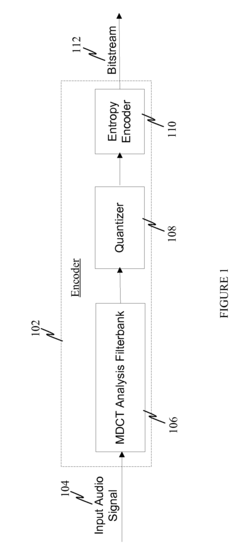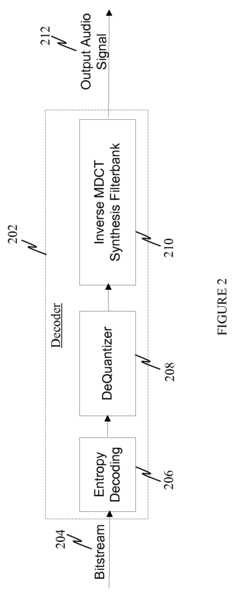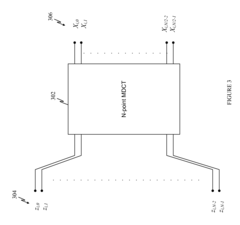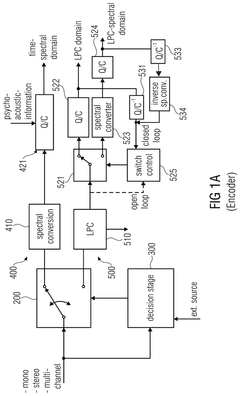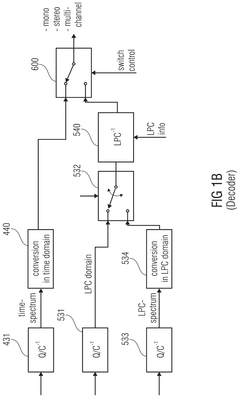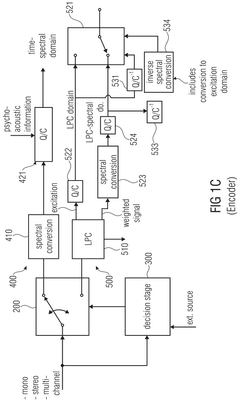How LDAC Increases Audio Codecs' Efficiency?
JUL 4, 20259 MIN READ
Generate Your Research Report Instantly with AI Agent
Patsnap Eureka helps you evaluate technical feasibility & market potential.
LDAC Technology Overview and Objectives
LDAC (Low Latency Audio Codec) is a cutting-edge audio coding technology developed by Sony Corporation to address the growing demand for high-quality wireless audio transmission. As the audio industry continues to evolve, there is an increasing need for efficient and high-fidelity audio codecs that can deliver superior sound quality over Bluetooth connections. LDAC aims to revolutionize the wireless audio experience by significantly improving codec efficiency and audio quality.
The primary objective of LDAC technology is to maximize the potential of Bluetooth audio transmission by utilizing available bandwidth more effectively. Unlike conventional codecs, LDAC can transmit up to 990 kbps of data, which is approximately three times the amount of data transmitted by standard Bluetooth codecs. This increased data rate allows for the transmission of high-resolution audio content, preserving more of the original sound quality.
LDAC's development can be traced back to the early 2010s when Sony recognized the limitations of existing Bluetooth audio codecs. The technology was officially introduced in 2015 and has since been adopted by various manufacturers in the audio industry. LDAC's evolution has been driven by the growing consumer demand for high-quality audio experiences in wireless devices, such as smartphones, headphones, and speakers.
One of the key technological advancements that LDAC brings to the table is its adaptive bit rate system. This feature allows the codec to dynamically adjust its data transmission rate based on the available wireless bandwidth and connection stability. By doing so, LDAC ensures optimal audio quality while maintaining a stable connection, even in challenging wireless environments.
LDAC also incorporates advanced psychoacoustic modeling techniques to enhance its encoding efficiency. These techniques take into account human auditory perception, allowing the codec to prioritize the most critical audio information for transmission. This approach results in a more efficient use of available bandwidth while maintaining high perceived audio quality.
The technology's efficiency is further improved through its implementation of sophisticated error correction and concealment algorithms. These algorithms help to mitigate the impact of data loss or corruption during transmission, ensuring a smoother and more consistent listening experience for users.
As the audio industry continues to push the boundaries of wireless audio quality, LDAC stands at the forefront of codec innovation. Its development represents a significant step towards bridging the gap between wired and wireless audio experiences, paving the way for future advancements in high-resolution audio streaming and immersive sound technologies.
The primary objective of LDAC technology is to maximize the potential of Bluetooth audio transmission by utilizing available bandwidth more effectively. Unlike conventional codecs, LDAC can transmit up to 990 kbps of data, which is approximately three times the amount of data transmitted by standard Bluetooth codecs. This increased data rate allows for the transmission of high-resolution audio content, preserving more of the original sound quality.
LDAC's development can be traced back to the early 2010s when Sony recognized the limitations of existing Bluetooth audio codecs. The technology was officially introduced in 2015 and has since been adopted by various manufacturers in the audio industry. LDAC's evolution has been driven by the growing consumer demand for high-quality audio experiences in wireless devices, such as smartphones, headphones, and speakers.
One of the key technological advancements that LDAC brings to the table is its adaptive bit rate system. This feature allows the codec to dynamically adjust its data transmission rate based on the available wireless bandwidth and connection stability. By doing so, LDAC ensures optimal audio quality while maintaining a stable connection, even in challenging wireless environments.
LDAC also incorporates advanced psychoacoustic modeling techniques to enhance its encoding efficiency. These techniques take into account human auditory perception, allowing the codec to prioritize the most critical audio information for transmission. This approach results in a more efficient use of available bandwidth while maintaining high perceived audio quality.
The technology's efficiency is further improved through its implementation of sophisticated error correction and concealment algorithms. These algorithms help to mitigate the impact of data loss or corruption during transmission, ensuring a smoother and more consistent listening experience for users.
As the audio industry continues to push the boundaries of wireless audio quality, LDAC stands at the forefront of codec innovation. Its development represents a significant step towards bridging the gap between wired and wireless audio experiences, paving the way for future advancements in high-resolution audio streaming and immersive sound technologies.
Market Demand for High-Quality Wireless Audio
The demand for high-quality wireless audio has been steadily increasing in recent years, driven by several key factors. Consumers are increasingly seeking immersive audio experiences across various devices, from smartphones and tablets to smart speakers and wireless headphones. This trend has been further accelerated by the growing popularity of streaming services, which offer high-resolution audio content, creating a need for wireless audio solutions that can deliver superior sound quality.
The market for wireless audio devices has seen significant growth, with a particular emphasis on premium audio products. High-end wireless headphones and earbuds have become status symbols, with consumers willing to pay a premium for superior sound quality and advanced features. This shift in consumer preferences has created a lucrative market segment for manufacturers who can deliver high-fidelity audio wirelessly.
The rise of mobile gaming and virtual reality applications has also contributed to the demand for high-quality wireless audio. Gamers and VR enthusiasts require low-latency, high-fidelity audio to enhance their immersive experiences. This has led to the development of specialized wireless audio codecs that can deliver near-lossless audio quality with minimal delay.
In the automotive industry, there is a growing demand for high-quality wireless audio systems in vehicles. As car manufacturers focus on creating premium in-car experiences, the integration of advanced wireless audio technologies has become a key differentiator in the luxury vehicle market.
The professional audio sector has also seen an increased demand for high-quality wireless audio solutions. Recording studios, live performance venues, and broadcast facilities are adopting wireless audio systems that can maintain studio-quality sound without the constraints of wired connections.
The COVID-19 pandemic has further amplified the importance of high-quality audio in remote work and communication scenarios. With the rise of video conferencing and remote collaboration, there is a growing need for wireless audio solutions that can deliver clear, high-fidelity sound for professional communication.
As the Internet of Things (IoT) ecosystem expands, the demand for seamless audio integration across various smart devices is increasing. Consumers expect their audio experiences to transition smoothly between different devices, creating a need for wireless audio technologies that can support multi-device connectivity while maintaining high sound quality.
These market trends have created a fertile ground for advanced audio codecs like LDAC, which aim to bridge the gap between wired and wireless audio quality. The ability to transmit high-resolution audio wirelessly without significant loss in quality has become a key selling point for audio device manufacturers, driving innovation in codec technology and creating new opportunities in the wireless audio market.
The market for wireless audio devices has seen significant growth, with a particular emphasis on premium audio products. High-end wireless headphones and earbuds have become status symbols, with consumers willing to pay a premium for superior sound quality and advanced features. This shift in consumer preferences has created a lucrative market segment for manufacturers who can deliver high-fidelity audio wirelessly.
The rise of mobile gaming and virtual reality applications has also contributed to the demand for high-quality wireless audio. Gamers and VR enthusiasts require low-latency, high-fidelity audio to enhance their immersive experiences. This has led to the development of specialized wireless audio codecs that can deliver near-lossless audio quality with minimal delay.
In the automotive industry, there is a growing demand for high-quality wireless audio systems in vehicles. As car manufacturers focus on creating premium in-car experiences, the integration of advanced wireless audio technologies has become a key differentiator in the luxury vehicle market.
The professional audio sector has also seen an increased demand for high-quality wireless audio solutions. Recording studios, live performance venues, and broadcast facilities are adopting wireless audio systems that can maintain studio-quality sound without the constraints of wired connections.
The COVID-19 pandemic has further amplified the importance of high-quality audio in remote work and communication scenarios. With the rise of video conferencing and remote collaboration, there is a growing need for wireless audio solutions that can deliver clear, high-fidelity sound for professional communication.
As the Internet of Things (IoT) ecosystem expands, the demand for seamless audio integration across various smart devices is increasing. Consumers expect their audio experiences to transition smoothly between different devices, creating a need for wireless audio technologies that can support multi-device connectivity while maintaining high sound quality.
These market trends have created a fertile ground for advanced audio codecs like LDAC, which aim to bridge the gap between wired and wireless audio quality. The ability to transmit high-resolution audio wirelessly without significant loss in quality has become a key selling point for audio device manufacturers, driving innovation in codec technology and creating new opportunities in the wireless audio market.
Current State and Challenges in Audio Codec Efficiency
The current state of audio codec efficiency is characterized by a continuous pursuit of higher quality audio transmission with lower bandwidth requirements. LDAC, developed by Sony, represents a significant advancement in this field, pushing the boundaries of what's possible in Bluetooth audio streaming.
Traditional audio codecs like SBC (Sub-band Coding) and AAC (Advanced Audio Coding) have been the standard for wireless audio transmission, but they often struggle to deliver high-fidelity audio within the constraints of Bluetooth bandwidth. This limitation has led to a compromise between audio quality and transmission efficiency, particularly noticeable in high-resolution audio playback.
LDAC addresses these challenges by employing advanced encoding techniques that allow for the transmission of up to 990 kbps of data, a substantial increase from the typical 328 kbps limit of other codecs. This higher bitrate enables LDAC to support 24-bit/96 kHz audio transmission, bringing it closer to lossless audio quality over Bluetooth.
One of the key innovations of LDAC is its adaptive bitrate feature. This allows the codec to dynamically adjust its data transmission rate based on the wireless environment and device capabilities. In optimal conditions, LDAC can operate at its highest bitrate, while in more challenging environments, it can scale down to ensure stable transmission without dropouts.
However, the implementation of LDAC faces several challenges. Firstly, hardware compatibility is a significant hurdle. Both the transmitting and receiving devices must support LDAC for the codec to function, limiting its widespread adoption. This creates a fragmented market where consumers may not always be able to take advantage of LDAC's benefits.
Another challenge lies in power consumption. The higher data processing requirements of LDAC can lead to increased battery drain on mobile devices, potentially offsetting its audio quality advantages in scenarios where battery life is a priority. Balancing high-quality audio transmission with energy efficiency remains an ongoing challenge for LDAC and similar advanced codecs.
Furthermore, the complexity of LDAC's encoding and decoding processes introduces latency concerns. While the codec is designed to minimize delay, the additional processing time required for its advanced algorithms can be noticeable in certain applications, particularly those requiring precise audio-visual synchronization.
As the demand for high-quality wireless audio continues to grow, driven by the increasing popularity of high-resolution music streaming services and advanced audio equipment, the pressure on audio codec efficiency intensifies. LDAC represents a significant step forward, but it also highlights the ongoing challenges in balancing audio quality, transmission efficiency, hardware compatibility, and power consumption in the evolving landscape of wireless audio technology.
Traditional audio codecs like SBC (Sub-band Coding) and AAC (Advanced Audio Coding) have been the standard for wireless audio transmission, but they often struggle to deliver high-fidelity audio within the constraints of Bluetooth bandwidth. This limitation has led to a compromise between audio quality and transmission efficiency, particularly noticeable in high-resolution audio playback.
LDAC addresses these challenges by employing advanced encoding techniques that allow for the transmission of up to 990 kbps of data, a substantial increase from the typical 328 kbps limit of other codecs. This higher bitrate enables LDAC to support 24-bit/96 kHz audio transmission, bringing it closer to lossless audio quality over Bluetooth.
One of the key innovations of LDAC is its adaptive bitrate feature. This allows the codec to dynamically adjust its data transmission rate based on the wireless environment and device capabilities. In optimal conditions, LDAC can operate at its highest bitrate, while in more challenging environments, it can scale down to ensure stable transmission without dropouts.
However, the implementation of LDAC faces several challenges. Firstly, hardware compatibility is a significant hurdle. Both the transmitting and receiving devices must support LDAC for the codec to function, limiting its widespread adoption. This creates a fragmented market where consumers may not always be able to take advantage of LDAC's benefits.
Another challenge lies in power consumption. The higher data processing requirements of LDAC can lead to increased battery drain on mobile devices, potentially offsetting its audio quality advantages in scenarios where battery life is a priority. Balancing high-quality audio transmission with energy efficiency remains an ongoing challenge for LDAC and similar advanced codecs.
Furthermore, the complexity of LDAC's encoding and decoding processes introduces latency concerns. While the codec is designed to minimize delay, the additional processing time required for its advanced algorithms can be noticeable in certain applications, particularly those requiring precise audio-visual synchronization.
As the demand for high-quality wireless audio continues to grow, driven by the increasing popularity of high-resolution music streaming services and advanced audio equipment, the pressure on audio codec efficiency intensifies. LDAC represents a significant step forward, but it also highlights the ongoing challenges in balancing audio quality, transmission efficiency, hardware compatibility, and power consumption in the evolving landscape of wireless audio technology.
LDAC Implementation and Technical Details
01 Improved LDAC codec efficiency
Enhancements to the LDAC (Low Delay Audio Codec) algorithm to improve its efficiency in audio compression and transmission. These improvements focus on optimizing the codec's performance, reducing latency, and maintaining high-quality audio output while minimizing power consumption.- LDAC codec optimization: Improvements in the Low Delay Audio Codec (LDAC) efficiency focus on optimizing the codec's performance. This includes enhancing compression algorithms, reducing latency, and improving overall audio quality while maintaining low power consumption. These optimizations aim to provide high-resolution audio transmission with minimal delay and efficient use of bandwidth.
- Power management in LDAC systems: Efficient power management is crucial for LDAC systems, especially in portable devices. This involves implementing power-saving techniques, optimizing battery usage, and developing energy-efficient circuitry. Such improvements contribute to longer battery life and better overall performance of LDAC-enabled devices.
- LDAC integration with wireless technologies: Integrating LDAC with various wireless technologies enhances its efficiency and applicability. This includes optimizing LDAC for Bluetooth transmission, Wi-Fi streaming, and other wireless protocols. The integration aims to improve connectivity, reduce interference, and ensure seamless audio transmission across different devices and platforms.
- LDAC signal processing enhancements: Advancements in signal processing techniques contribute to improved LDAC efficiency. This involves developing sophisticated algorithms for noise reduction, error correction, and adaptive bit rate adjustment. These enhancements result in clearer audio output, improved resistance to interference, and better overall codec performance.
- LDAC implementation in automotive systems: Adapting LDAC for automotive applications focuses on improving efficiency in vehicle audio systems. This includes optimizing the codec for in-car entertainment systems, integrating it with vehicle communication networks, and ensuring compatibility with various automotive audio formats. These implementations aim to enhance the audio experience in vehicles while maintaining efficiency and reliability.
02 Energy-efficient LDAC implementation
Development of energy-efficient hardware and software implementations for LDAC encoding and decoding. These solutions aim to reduce power consumption in devices utilizing LDAC technology, particularly in battery-powered portable audio devices and wireless headphones.Expand Specific Solutions03 LDAC integration with wireless audio systems
Integration of LDAC technology into various wireless audio systems, including Bluetooth devices, to enhance audio quality and efficiency in wireless transmission. This includes optimizing LDAC for different wireless protocols and improving its compatibility with existing audio ecosystems.Expand Specific Solutions04 Adaptive LDAC encoding techniques
Development of adaptive encoding techniques for LDAC to dynamically adjust compression levels based on audio content, network conditions, and device capabilities. These techniques aim to optimize audio quality and transmission efficiency in real-time scenarios.Expand Specific Solutions05 LDAC efficiency in multi-device environments
Improvements in LDAC efficiency for multi-device environments, such as smart home systems or multi-room audio setups. These advancements focus on optimizing LDAC performance when multiple audio streams are being transmitted simultaneously to different devices.Expand Specific Solutions
Key Players in Wireless Audio Technology
The LDAC audio codec technology market is in a growth phase, driven by increasing demand for high-quality wireless audio solutions. The market size is expanding rapidly, with major players like Sony, Samsung, and Qualcomm leading the way. LDAC's technical maturity is advancing, as evidenced by its adoption by various companies. Sony, the original developer, has been joined by other tech giants like Samsung and Huawei in implementing LDAC. Research institutions such as Fraunhofer-Gesellschaft and Electronics & Telecommunications Research Institute are also contributing to the technology's evolution. The competitive landscape is dynamic, with companies like Cirrus Logic and Analog Devices developing complementary audio processing solutions to enhance LDAC's efficiency.
Fraunhofer-Gesellschaft eV
Technical Solution: Fraunhofer's Enhanced Low Delay AAC (AAC-ELD) codec improves audio efficiency for communication applications. It achieves high audio quality at bit rates ranging from 24 to 64 kbps per channel, with algorithmic delays as low as 15 ms[10]. AAC-ELD employs spectral band replication (SBR) and parametric stereo (PS) techniques to reconstruct high-frequency content and stereo image with minimal data overhead. The codec also features a robust error concealment mechanism, ensuring audio quality in challenging network conditions[11]. Fraunhofer's technology includes adaptive pre-echo control and temporal noise shaping, which contribute to improved audio quality at lower bit rates[12].
Strengths: Very low latency, high efficiency at low bit rates, robust error concealment. Weaknesses: Potentially lower audio quality at highest settings compared to some hi-res codecs, limited adoption in consumer electronics.
Sony Group Corp.
Technical Solution: Sony's LDAC technology significantly increases audio codec efficiency by employing a variable bit rate system that can transmit up to 990 kbps[1]. This is approximately three times the data transmitted by conventional Bluetooth audio codecs. LDAC uses sophisticated encoding and decoding algorithms to maximize the use of the available bandwidth, allowing for near Hi-Res Audio quality over Bluetooth[2]. The codec dynamically adjusts its bit rate based on wireless connection stability, ensuring optimal audio quality and connection reliability. LDAC also incorporates advanced error correction and concealment techniques to maintain audio integrity even in challenging wireless environments[3].
Strengths: Superior audio quality, adaptive bit rate for stability, wide device compatibility. Weaknesses: Higher power consumption, potential latency issues in some scenarios.
Core Innovations in LDAC Audio Compression
Efficient implementation of analysis and synthesis filterbanks for MPEG AAC and MPEG AAC ELD encoders/decoders
PatentInactiveUS20090099844A1
Innovation
- A common core MDCT analysis and IMDCT synthesis filterbank is used, with specific sign inversion and order reversal operations to enable the implementation of both AAC and AAC ELD algorithms, allowing for reusability of existing code with minimal modifications.
Low bitrate audio encoding/decoding scheme having cascaded switches
PatentPendingUS20250069608A1
Innovation
- An audio encoder that employs two distinct coding branches, one using a frequency-domain algorithm and the other using a Linear Predictive Coding (LPC) algorithm, allowing for switching between the two based on the characteristics of the audio signal. This approach involves converting the audio signal into different domains and processing it accordingly to optimize encoding.
Compatibility and Ecosystem Integration
LDAC's compatibility and ecosystem integration play a crucial role in its widespread adoption and effectiveness in increasing audio codec efficiency. The technology has been designed to seamlessly integrate with a variety of devices and platforms, ensuring a broad ecosystem that supports high-quality audio transmission.
One of the key aspects of LDAC's compatibility is its integration with the Android operating system. Since Android 8.0 (Oreo), LDAC has been natively supported, allowing a wide range of Android smartphones and tablets to utilize this advanced audio codec. This native support eliminates the need for additional software or drivers, making it easier for manufacturers to implement LDAC in their devices.
Beyond Android devices, LDAC has also been adopted by numerous audio equipment manufacturers. Many high-end wireless headphones, earbuds, and speakers now support LDAC, providing consumers with more options for experiencing high-quality audio. This widespread adoption has created a robust ecosystem of LDAC-compatible devices, further driving its popularity and effectiveness.
The technology's compatibility extends to various music streaming services as well. Major platforms like Tidal, Amazon Music HD, and Qobuz support high-resolution audio streaming, which can take full advantage of LDAC's capabilities. This integration ensures that users can access high-quality audio content that matches LDAC's enhanced transmission capabilities.
LDAC's ecosystem integration also includes its compatibility with other Bluetooth audio codecs. Devices that support LDAC typically also support other codecs like SBC, AAC, and aptX, ensuring backward compatibility with older devices or those that don't support LDAC. This flexibility allows LDAC-enabled devices to maintain optimal audio quality across various scenarios and device pairings.
Furthermore, LDAC's integration extends to professional audio equipment and studio-grade systems. Its ability to transmit high-resolution audio wirelessly makes it valuable in professional recording and production environments, expanding its ecosystem beyond consumer electronics.
The technology's compatibility with various Bluetooth versions, including the latest Bluetooth 5.0 and above, ensures that it can take advantage of improvements in wireless transmission technology. This forward-compatibility helps maintain LDAC's efficiency and relevance as Bluetooth technology continues to evolve.
One of the key aspects of LDAC's compatibility is its integration with the Android operating system. Since Android 8.0 (Oreo), LDAC has been natively supported, allowing a wide range of Android smartphones and tablets to utilize this advanced audio codec. This native support eliminates the need for additional software or drivers, making it easier for manufacturers to implement LDAC in their devices.
Beyond Android devices, LDAC has also been adopted by numerous audio equipment manufacturers. Many high-end wireless headphones, earbuds, and speakers now support LDAC, providing consumers with more options for experiencing high-quality audio. This widespread adoption has created a robust ecosystem of LDAC-compatible devices, further driving its popularity and effectiveness.
The technology's compatibility extends to various music streaming services as well. Major platforms like Tidal, Amazon Music HD, and Qobuz support high-resolution audio streaming, which can take full advantage of LDAC's capabilities. This integration ensures that users can access high-quality audio content that matches LDAC's enhanced transmission capabilities.
LDAC's ecosystem integration also includes its compatibility with other Bluetooth audio codecs. Devices that support LDAC typically also support other codecs like SBC, AAC, and aptX, ensuring backward compatibility with older devices or those that don't support LDAC. This flexibility allows LDAC-enabled devices to maintain optimal audio quality across various scenarios and device pairings.
Furthermore, LDAC's integration extends to professional audio equipment and studio-grade systems. Its ability to transmit high-resolution audio wirelessly makes it valuable in professional recording and production environments, expanding its ecosystem beyond consumer electronics.
The technology's compatibility with various Bluetooth versions, including the latest Bluetooth 5.0 and above, ensures that it can take advantage of improvements in wireless transmission technology. This forward-compatibility helps maintain LDAC's efficiency and relevance as Bluetooth technology continues to evolve.
Power Consumption and Battery Life Implications
LDAC's impact on power consumption and battery life is a critical consideration for its implementation in portable audio devices. The codec's high-efficiency encoding and transmission process contributes to reduced power usage compared to traditional Bluetooth audio codecs.
LDAC employs advanced algorithms that optimize data compression without compromising audio quality. This efficient compression reduces the amount of data that needs to be transmitted, directly correlating to lower power consumption during wireless audio streaming. The reduced data transmission also means less processing power is required on both the transmitting and receiving devices, further contributing to energy savings.
The codec's adaptive bit rate feature allows it to adjust its performance based on the wireless connection quality and device capabilities. This dynamic adjustment ensures that power is not wasted on unnecessarily high bit rates when network conditions are suboptimal, effectively balancing audio quality with power efficiency.
In practical terms, the power savings achieved by LDAC can translate to extended battery life for both the audio source device (such as a smartphone) and the receiving device (like wireless headphones or speakers). This improvement in battery performance is particularly noticeable during long listening sessions or in scenarios where frequent device charging is inconvenient.
However, it's important to note that the actual impact on battery life can vary depending on several factors. These include the specific hardware implementation, the chosen bit rate mode, and the overall system design of the audio devices. While LDAC generally offers power efficiency benefits, the extent of these benefits may differ across various device models and usage scenarios.
For device manufacturers, LDAC's power efficiency presents an opportunity to design products with smaller batteries without compromising on playback time. This can lead to more compact and lightweight audio devices, enhancing portability and user comfort. Alternatively, manufacturers can maintain current battery sizes to offer extended usage times, providing a competitive edge in the market.
As the demand for high-quality wireless audio continues to grow, the power efficiency of codecs like LDAC becomes increasingly important. It allows consumers to enjoy superior audio quality without significant compromises in device battery life, addressing a key concern in the adoption of high-resolution wireless audio technologies.
LDAC employs advanced algorithms that optimize data compression without compromising audio quality. This efficient compression reduces the amount of data that needs to be transmitted, directly correlating to lower power consumption during wireless audio streaming. The reduced data transmission also means less processing power is required on both the transmitting and receiving devices, further contributing to energy savings.
The codec's adaptive bit rate feature allows it to adjust its performance based on the wireless connection quality and device capabilities. This dynamic adjustment ensures that power is not wasted on unnecessarily high bit rates when network conditions are suboptimal, effectively balancing audio quality with power efficiency.
In practical terms, the power savings achieved by LDAC can translate to extended battery life for both the audio source device (such as a smartphone) and the receiving device (like wireless headphones or speakers). This improvement in battery performance is particularly noticeable during long listening sessions or in scenarios where frequent device charging is inconvenient.
However, it's important to note that the actual impact on battery life can vary depending on several factors. These include the specific hardware implementation, the chosen bit rate mode, and the overall system design of the audio devices. While LDAC generally offers power efficiency benefits, the extent of these benefits may differ across various device models and usage scenarios.
For device manufacturers, LDAC's power efficiency presents an opportunity to design products with smaller batteries without compromising on playback time. This can lead to more compact and lightweight audio devices, enhancing portability and user comfort. Alternatively, manufacturers can maintain current battery sizes to offer extended usage times, providing a competitive edge in the market.
As the demand for high-quality wireless audio continues to grow, the power efficiency of codecs like LDAC becomes increasingly important. It allows consumers to enjoy superior audio quality without significant compromises in device battery life, addressing a key concern in the adoption of high-resolution wireless audio technologies.
Unlock deeper insights with Patsnap Eureka Quick Research — get a full tech report to explore trends and direct your research. Try now!
Generate Your Research Report Instantly with AI Agent
Supercharge your innovation with Patsnap Eureka AI Agent Platform!

